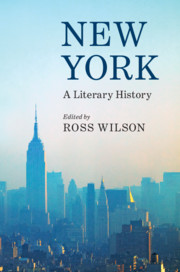75 results
9 - Shelley in the Overgrowth
-
-
- Book:
- Percy Shelley for Our Times
- Published online:
- 07 March 2024
- Print publication:
- 14 March 2024, pp 195-213
-
- Chapter
- Export citation
Chapter 5 - The ‘Postscript’
- from Part I - General
-
-
- Book:
- Walter Pater and the Beginnings of English Studies
- Published online:
- 14 November 2023
- Print publication:
- 09 November 2023, pp 104-117
-
- Chapter
- Export citation
Chapter 10 - Strange Designs: Byron, Shelley and Ottava Rima
- from Part II - Contemporaries
-
-
- Book:
- Byron Among the English Poets
- Published online:
- 22 July 2021
- Print publication:
- 29 July 2021, pp 174-187
-
- Chapter
- Export citation
Copyright page
-
- Book:
- New York
- Published online:
- 19 February 2020
- Print publication:
- 27 February 2020, pp iv-iv
-
- Chapter
- Export citation
Bibliography
-
- Book:
- New York
- Published online:
- 19 February 2020
- Print publication:
- 27 February 2020, pp 296-321
-
- Chapter
- Export citation
Chapter 11 - Wartime Reading in the City, 1914–1918
- from Part III - Identity and Place
-
-
- Book:
- New York
- Published online:
- 19 February 2020
- Print publication:
- 27 February 2020, pp 152-164
-
- Chapter
- Export citation
Index
-
- Book:
- New York
- Published online:
- 19 February 2020
- Print publication:
- 27 February 2020, pp 322-324
-
- Chapter
- Export citation
Part I - Adaptation and Adjustment
-
- Book:
- New York
- Published online:
- 19 February 2020
- Print publication:
- 27 February 2020, pp 17-76
-
- Chapter
- Export citation
Part II - Innovation and Inspiration
-
- Book:
- New York
- Published online:
- 19 February 2020
- Print publication:
- 27 February 2020, pp 77-136
-
- Chapter
- Export citation
Part IV - Tragedy and Hope
-
- Book:
- New York
- Published online:
- 19 February 2020
- Print publication:
- 27 February 2020, pp 213-295
-
- Chapter
- Export citation
Acknowledgements
-
- Book:
- New York
- Published online:
- 19 February 2020
- Print publication:
- 27 February 2020, pp x-x
-
- Chapter
- Export citation
Part III - Identity and Place
-
- Book:
- New York
- Published online:
- 19 February 2020
- Print publication:
- 27 February 2020, pp 137-212
-
- Chapter
- Export citation
Chapter 1 - Introduction
-
-
- Book:
- New York
- Published online:
- 19 February 2020
- Print publication:
- 27 February 2020, pp 1-16
-
- Chapter
- Export citation
Contents
-
- Book:
- New York
- Published online:
- 19 February 2020
- Print publication:
- 27 February 2020, pp v-vii
-
- Chapter
- Export citation
Contributors
-
- Book:
- New York
- Published online:
- 19 February 2020
- Print publication:
- 27 February 2020, pp viii-ix
-
- Chapter
- Export citation

New York
- A Literary History
-
- Published online:
- 19 February 2020
- Print publication:
- 27 February 2020
Chapter 5 - ‘We Manufacture Fun’: Capital and the Production of Affect
- from I - Origins
-
-
- Book:
- Affect and Literature
- Published online:
- 16 January 2020
- Print publication:
- 06 February 2020, pp 100-115
-
- Chapter
- Export citation
High-resolution seismic imaging reveals infill history of a submerged Quaternary fjord system in the subantarctic Auckland Islands, New Zealand
-
- Journal:
- Quaternary Research / Volume 93 / January 2020
- Published online by Cambridge University Press:
- 28 October 2019, pp. 255-266
-
- Article
- Export citation
Self-reported sleep disturbances are associated with poorer cognitive performance in older adults with hypertension: a multi-parameter risk factor investigation
-
- Journal:
- International Psychogeriatrics / Volume 32 / Issue 7 / July 2020
- Published online by Cambridge University Press:
- 24 October 2019, pp. 815-825
-
- Article
-
- You have access
- Open access
- HTML
- Export citation
Beyond first-degree heart block in the diagnosis of acute rheumatic fever
-
- Journal:
- Cardiology in the Young / Volume 29 / Issue 6 / June 2019
- Published online by Cambridge University Press:
- 14 June 2019, pp. 744-748
-
- Article
- Export citation



